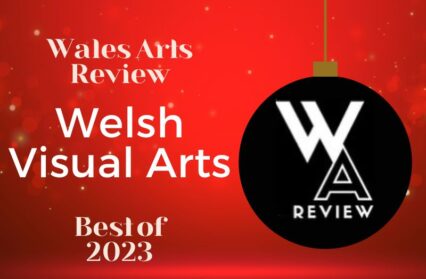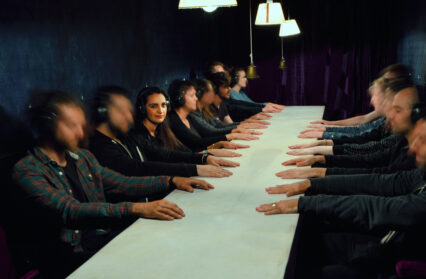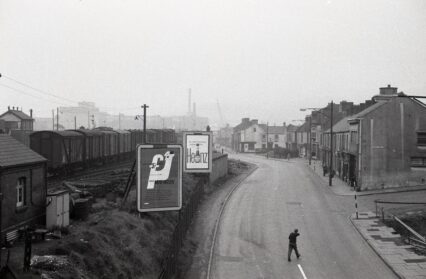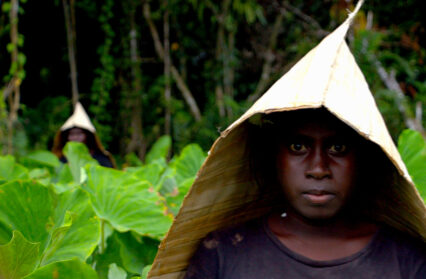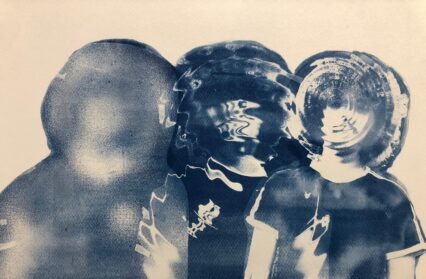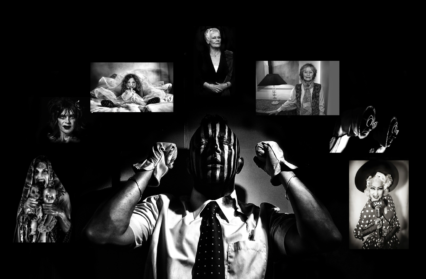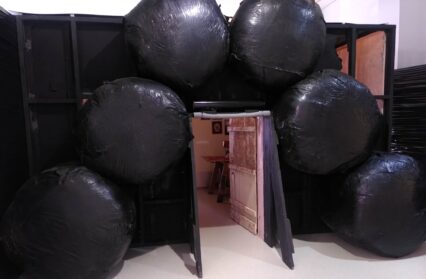Adam Somerset is at Aberystwyth Arts Centre to review David Hurn’s exhibition at The Eye International Photography Festival.
Aberystwyth Arts Centre is nothing if not energetic. Cardiff photographer Glenn Edwards has been a regular part of the long-established International Pottery Festival. That festival takes place biannually and it has been Edwards’ idea to fill the intervening year with a festival devoted to photography.
Management speak gets much lampooned for its jargonised Latinity, but sweating your assets is as juicily physical a metaphor as ever was. Theatre and comedy tours run down in late June. The arrival of the company for the summer musical is imminent but Aberystwyth’s main auditorium is vacant for seventy-two hours. Glen Edwards and Arts Centre director Alan Hewson have filled it with photographers and picture editors from, among many, the Magnum Group, the Observer and the Independent. The quality of the line-up has brought in visitors from across Britain.
Veteran Welsh photographer David Hurn is keynote speaker for the opening evening. He speaks and takes questions over an hour and a half. Aided by seventy illustrative images he is a model of what the practitioner-critic should be. He is in service to the craft and the craft has precedence over promotion of the self. He has a deep sense for the medium’s history. An awareness of ethics lives alongside a regard for aesthetics. He opens his talk on a note of pragmatism. To aspirant picture-makers, he says, ‘Make sure you get a good pair of shoes. You will need them.’
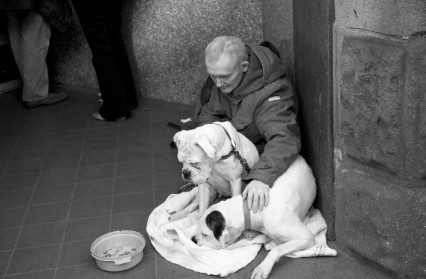
His thesis is simple. The photographer is there. He is an eye, the witness, who works to make something that hits the viewer in the gut. Whether the intervening machinery is made by Fuji or Leica is neither here nor there, it is personal preference. The equipment is just the tool. Photography is emotion. His first illustration is an unnerving double lynching from 1930’s Indiana.
He is an exponent of craft. Getting into Art College alone will not make an artist. ‘What is the essence of being a concert pianist,’ he once enquired of Daniel Barenboim. ‘You get to play the piano a lot,’ is the master’s reply. Get on with making photographs, he says; lots and lots of them. If others choose to tell you that you are an artist, that is fine. It is the right stance. Despite the best efforts of a strand of educationalists, artistry is an issue of attribution, not self-declaration.
David Hurn goes back one hundred-and-thirty years in photography’s history. In the 1880’s a technical leap takes the camera out of the province of a wealthy few to being available to the many. Almost instantly, comment and criticism erupt. Hurn owns a collection of one thousand plus postcards that feature a camera. He shows a saucy postcard from the nineteen-sixties then four more from previous eras. The costumes change but the joke of the leering and blackmailing photographer is unchanged.
All art forms have their ethics. Privacy issues, control and restriction have long dogged the making of public images. Members of my family once found themselves, much to their surprise, witnesses to a 1960’s filming of the Battle of Actium. In front of their eyes the star’s attendants knocked a photographer to the ground and trampled on his camera.
David Hurn in his approach to ethics prefers a hanging question mark to a Sontag or Berger-style certitude. He shows a contact sheet where Marilyn Monroe has scored out those pictures she wished to be kept private. The photographer sells them to a mass magazine the instant she dies. This invites disapproval, but Hurn promptly follows up with a Heinrich Hoffmann picture of Hitler. The Fuhrer too forbade all images that showed him in spectacles. Should there be one rule maybe, he muses, for the good but a different one for the bad?
David Alston from the Arts Council of Wales has opened the festival with a reminder that photography is document. That word, he says, has its roots in the Latin for ‘teach’. Hurn’s selection of pictures covers the span of fact and imagination. After a heart-achingly romantic 1915 Kertesz he shows a puzzle picture. A line of men may be participants in a peculiar religious rite. Look closer and some small rubber suckers reveal they are doing no more than nudging a plate glass window into place. He shows a Duane Michals sequence of a surreal and witty circularity. Richard Avedon sends a brave model to pose in a convex curve between two elephants.
Where there is art there is money. But the notion of value is turned on its head when the work is infinitely reproducible. Early on, in chemical days dealers recommended a negative’s destruction. As for the aesthetics of the genre David Hurn reports the New York Times chiding Salgado for being ‘too beautiful’. Eve Arnold captures Monroe’s face in the crook of her arm in a bathroom mirror. Her body is aslant; more width in the picture is given to the basin than to the person. ‘I love the wrongness of it,’ he says.
Lastly, we are taken to the world that is beyond the human eye. The explosion of an apple as a bullet passes through it is as counter-intuitive as Muybridge’s horses’ legs. And photography colonises our inner world. Hurn shows us ‘the most important photograph of his life.’ The probing, intruding micro-lens of the radiographer captures an alien bloody cancer. It is document all right; it teaches the surgeon exactly where and what to cut.
The question and answer session seeks to equate Hurn’s plea for authenticity with the rendering via Lightbox of colour into black and white. But then colour is not an objective fact. Electrons hit the retina’s rods and cones in any number of unknown variations. But giving fashion models Barbie-length limbs is another issue. Photography’s authority needs to place authenticity over human re-arrangement. Where fidelity to appearance is changed it needs a signature, like that of a Man Ray that states it to be so.
A new festival looks to a good opening. It sets the tone, gives it vim and impetus. David Hurn provides a fine, broad-seeing one.



